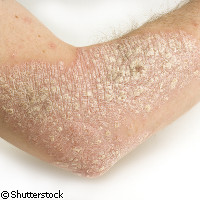Link between missing genes and psoriasis risk found
Psoriasis, an inflammatory skin condition, affects 1% to 5% of the population in each European country. Prevalence is higher in Scandinavia and northern Europe. Setting their sights on identifying who is more likely to suffer from this chronic condition, a group of genetics experts at the University of Nottingham in the UK found that people lacking the genes LCE3B and LCE3C have a greater chance of being affected. Their results were recently published in the journal Nature Genetics. The LCE3B (late cornified envelope 3B) and LCE3C (late cornified envelope 3C) genes act as protectors of the human skin. Without them, the skin is more or less left to fend on its own and fight the sequence of damage and inflammation that triggers psoriasis. The researchers found that the absence of the two genes is strongly linked with the risk of psoriasis in the 2,831 people participating in the research (from Italy, the Netherlands, Spain and the UK). 'Measuring gene numbers accurately is technically challenging but is necessary to demonstrate this kind of effect,' explained Professor John Armour from the Institute of Genetics and School of Biology at the University of Nottingham, a research team member. 'This new report adds to the growing number of examples of disorders caused by variation in the number of genes, and suggests that there may be many more examples to come,' he added. 'What's especially interesting about this example is that in the UK lacking these genes is actually (more common) than having them.' Research has shown that around a third of those affected by psoriasis are not alone; someone in their family also suffers from this condition. While experts have long known that genetic predisposition plays a major role in determining who will be affected by psoriasis, it is only recently that researchers have been able to determine the exact nature of the variations that 'give rise to that predisposition', they say. Overall, five types of psoriasis have been identified, and between 10% and 30% of people suffering from the disease develop a form of arthritis called psoriatic arthritis, the inflammation of the joints. The most common form (affecting around 80% of sufferers) causes plaques of scaly, itchy skin, and is usually found in prominent areas like the knees and elbows, lower back and scalp. Other types are guttate psoriasis (small, red spots on the skin), pustular psoriasis (white pustules surrounded by red skin), inverse psoriasis (smooth, red lesions in skin folds) and erythrodermic psoriasis (extensive redness with severe itching and pain). There is no cure, but patients can help control the signs and symptoms through lifelong therapy, which depends on the type and severity of the psoriasis. Data show that while Caucasians are most affected by psoriasis, the disorder is far less common among Asians. Signs and symptoms of psoriasis typically emerge in people around the ages of 15 and 35, and around 75% of those who develop the disorder are diagnosed before they turn 40. The other peak onset is between 50 and 60 years of age, experts say. The international study was coordinated by Professor Xavier Estivill at Pompeu Fabra University in Barcelona, Spain.



